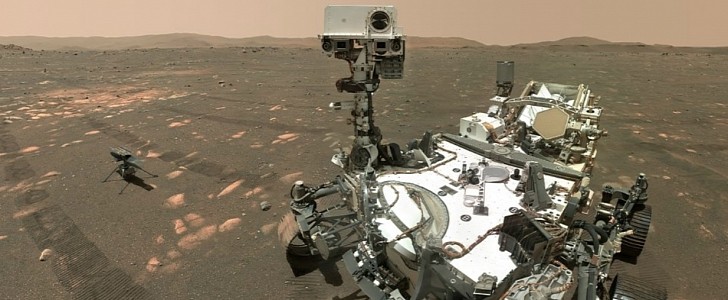It's been one year since NASA's car-sized rover Perseverance has landed on Mars, together with its helicopter buddy, Ingenuity. During its stay on the Red Planet, the rover has accomplished incredible things, and it continues to impress with its discoveries.
One of the key objectives for Perseverance on Mars is searching for signs of ancient microbial life. To that end, the rover has been busy exploring the layers of exposed bedrock in the Jezero Crater, a region believed to have once been filled with liquid water.
To investigate this intriguing area, the rover is loaded with scientific instruments. In its belly is located the equipment it needs to collect samples from Mars, and it includes a rotating drill carousel, which is a wheel with different drill bits, and 43 sample tubes.
So far, Perseverance has successfully filled six samples tubes with fragments of the Red Planet. The rover will continue to collect pieces of the alien world and store them in its belly until it deposits them on the Martian surface to be retrieved by a future mission.
By the end of the decade, NASA, together with European Space Agency (ESA), plans to launch the Mars Sample Return mission. The effort involves several spacecraft and robotic systems that will all work together to bring back to Earth the samples left by Perseverance.
Once they reach terrestrial laboratories, scientists will be able to finally analyze the alien fragments with powerful, complex laboratory equipment that would be just too big to transport to Mars.
But that's not the only thing that the rover will be doing on the Red Planet. Perseverance will also continue to study the planet's geology and past climate using its other instruments onboard. With MEDA (Mars Environmental Dynamics Analyzer), it will measure the weather and monitor dust.
On its head, it has the Mastcam-Z camera that it uses to take stunning images of its surroundings. Right next to it is the Supercam (which resembles a big eye), which can identify the chemical composition of rocks from more than 20 feet (7 meters) away. Supercam is also helped by the SHERLOC instrument and the X-ray fluorescence spectrometer PIXL.
And the rover is not capable of only analyzing Mars' composition. It can also create oxygen with MOXIE (Mars Oxygen In-Situ Resource Utilization Experiment) from the carbon dioxide found in the atmosphere.
The rover will continue to search for signs of ancient microbial life and test technologies for future human exploration of the red, cold planet. And it won't be alone – Ingenuity will be there and will explore how future rovers and aircraft can work together on Mars.
To investigate this intriguing area, the rover is loaded with scientific instruments. In its belly is located the equipment it needs to collect samples from Mars, and it includes a rotating drill carousel, which is a wheel with different drill bits, and 43 sample tubes.
So far, Perseverance has successfully filled six samples tubes with fragments of the Red Planet. The rover will continue to collect pieces of the alien world and store them in its belly until it deposits them on the Martian surface to be retrieved by a future mission.
By the end of the decade, NASA, together with European Space Agency (ESA), plans to launch the Mars Sample Return mission. The effort involves several spacecraft and robotic systems that will all work together to bring back to Earth the samples left by Perseverance.
Once they reach terrestrial laboratories, scientists will be able to finally analyze the alien fragments with powerful, complex laboratory equipment that would be just too big to transport to Mars.
But that's not the only thing that the rover will be doing on the Red Planet. Perseverance will also continue to study the planet's geology and past climate using its other instruments onboard. With MEDA (Mars Environmental Dynamics Analyzer), it will measure the weather and monitor dust.
On its head, it has the Mastcam-Z camera that it uses to take stunning images of its surroundings. Right next to it is the Supercam (which resembles a big eye), which can identify the chemical composition of rocks from more than 20 feet (7 meters) away. Supercam is also helped by the SHERLOC instrument and the X-ray fluorescence spectrometer PIXL.
And the rover is not capable of only analyzing Mars' composition. It can also create oxygen with MOXIE (Mars Oxygen In-Situ Resource Utilization Experiment) from the carbon dioxide found in the atmosphere.
The rover will continue to search for signs of ancient microbial life and test technologies for future human exploration of the red, cold planet. And it won't be alone – Ingenuity will be there and will explore how future rovers and aircraft can work together on Mars.







